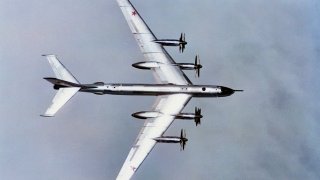Russia's Tu-95: The Old Bomber That Just Might Be Near Unstoppable
In early May, the U.S. Air Force intercepted two Russian Tu-95 "Bear" bombers near Alaska, highlighting the enduring relevance of this Cold War-era aircraft.
Summary and Top Points: In early May, the U.S. Air Force intercepted two Russian Tu-95 "Bear" bombers near Alaska, highlighting the enduring relevance of this Cold War-era aircraft.
-The Russian Ministry of Defense stated that the bombers were conducting an 11-hour flight over neutral waters in the Bering Sea, showcasing Moscow's commitment to long-range aviation capabilities.
-First flown in 1952, the Tu-95 was designed to counter U.S. strategic bombers and has since become a mainstay of Russia's aerial fleet. Notably, a Tu-95 variant was used to drop the Tsar Bomba, the most powerful nuclear weapon ever detonated.
-Over the years, multiple variants have been developed, including models equipped for naval reconnaissance and missile launch capabilities.
Tu-95 Bear Bombers: Russia's Timeless Threat Intercepted Near Alaska
The U.S. Air Force reportedly intercepted Russian Tu-95 bombers near Alaska in early May. According to the Russian Ministry of Defense, two “Bear Bombers’ were conducting a flight over the Bering Strait when American F-16 Fighting Falcons were scrambled to escort them away.
"Two Tu-95MS strategic missile-carrying bombers of the Russian Aerospace Forces' long-range aviation carried out a scheduled flight in the airspace over the neutral waters of the Bering Sea near the western coast of Alaska. The flight lasted over 11 hours. The crews of Su-30SM aircraft of the Aerospace Forces provided fighter support," the Russian Ministry of Defense said in a statement to TASS.
By flying the Tu-95 near Alaska, Moscow was demonstrating its commitment to long-range aviation capabilities. This Cold War-era aircraft has remained in service for more than half a century, adopting new roles over the years to retain its relevance. Despite its old age, the Bear Bomber remains a mainstay of Russia's aerial fleet.
Introducing the Tu-95 Bear Bomber
In order to counter the strategic bombers fielded by the U.S. military during the Second World War, Soviet engineers envisioned a homegrown counterpart. The USSR first issued a request in 1950 for a four-engine bomber capable of flying 5,000 miles to strike targets across the continental U.S. Some consider the Tu-95 bear Russia's own version of the B-52 bomber - just in turboprop form.
The Bear was fitted with four Kuznetsov turboprop engines equipped with two contra-rotating four-blade propellers. The Soviets opted for the turboprop engines because early jet engines burned a lot of fuel in flight. The Bear’s powerful engine system was designed by Ferdinand Brandner – a Nazi party member who was captured by Soviet troops after attempting to flee to Prague toward the end of the war.
The Tu-95 took its maiden flight in 1952 and officially entered service with the Soviet Air Force a few years later. In 1961, Khrushchev revealed that the USSR was planning to detonate the most powerful nuclear bomb in the world. The Tsar Bomba, also referred to by its designation, AN602, was eventually dropped by parachute aboard a Tu-95V aircraft. This modified Bear variant was equipped with redesigned engines, suspensions, and release mechanisms in order to successfully release the large nuclear weapon.
Over the years, other Bear bomber variants were created, including the Tu-142 Russian Air Force naval aviation model. As detailed by Airforce Technology, “The Bear J radio relay aircraft are equipped with VLF communications sets with a VLF ventral antenna pod under the centre fuselage. The satellite communications radome is installed just to the aft of the flight deck canopy. The aircraft maintain communications between the submarines of the Northern and Pacific fleets and the Russian command stations.”
Other experimental Bears were envisioned by the Soviets, including the Tu-95LAL and the Tu-95K. The variants that made it to the production phase include the Tu-95MR photo-reconnaissance aircraft and the Tu-95K, which is capable of launching Kh-22 missiles.
About the Author: Maya Carlin
Maya Carlin, National Security Writer with The National Interest, is an analyst with the Center for Security Policy and a former Anna Sobol Levy Fellow at IDC Herzliya in Israel. She has by-lines in many publications, including The National Interest, Jerusalem Post, and Times of Israel. You can follow her on Twitter: @MayaCarlin.
Image Credit: Shutterstock.


